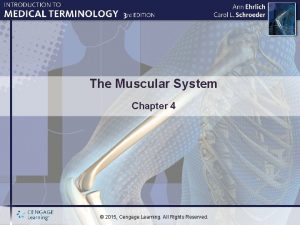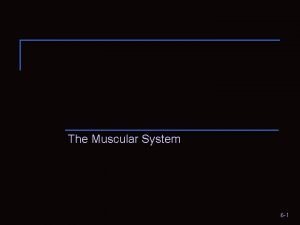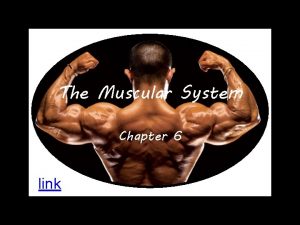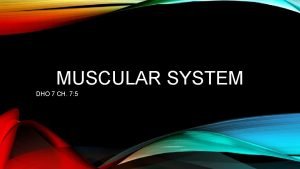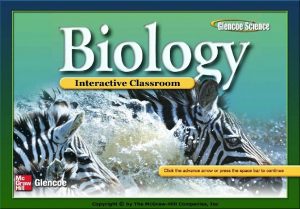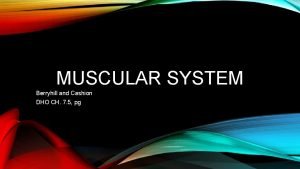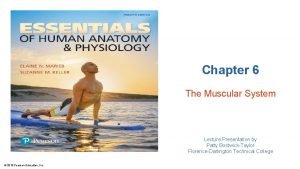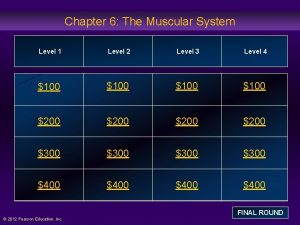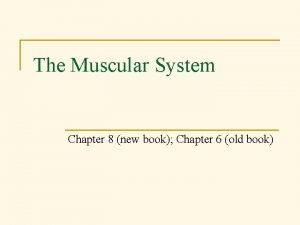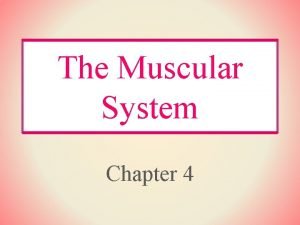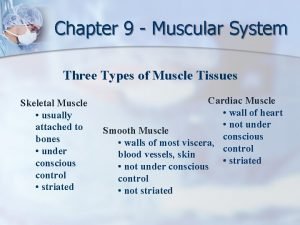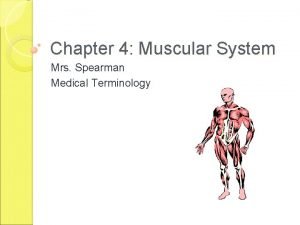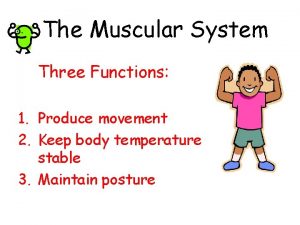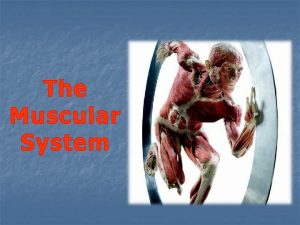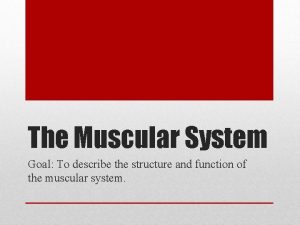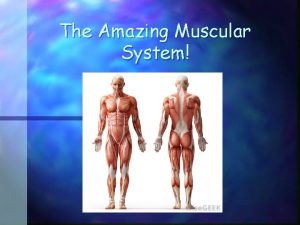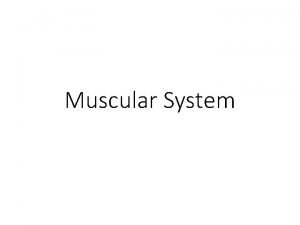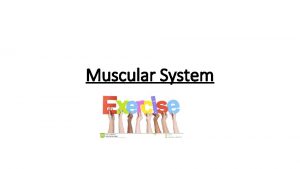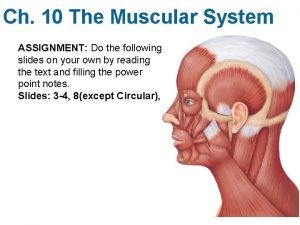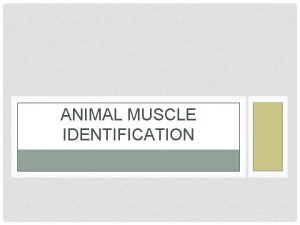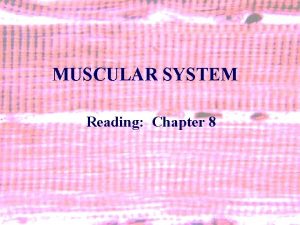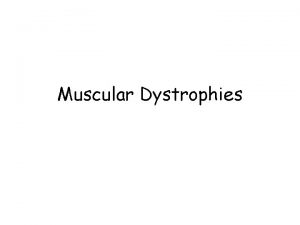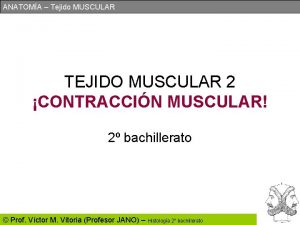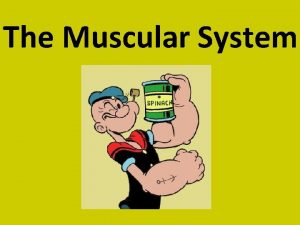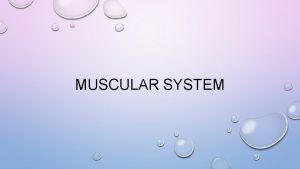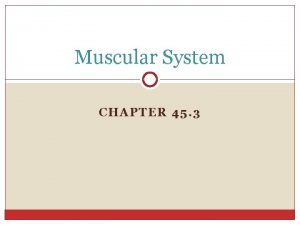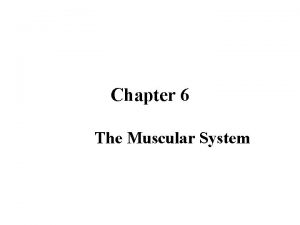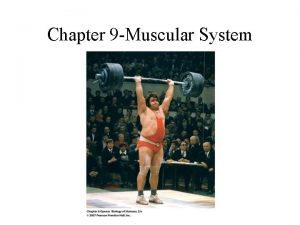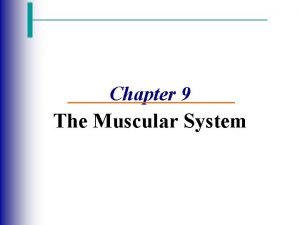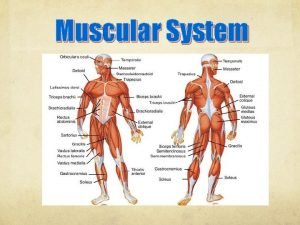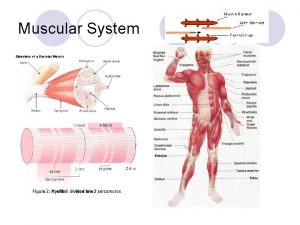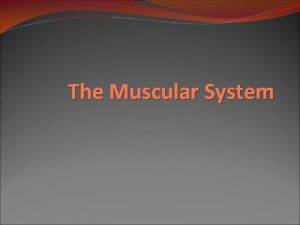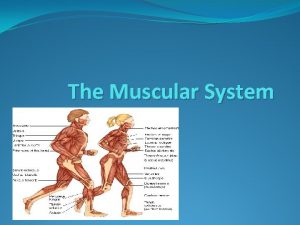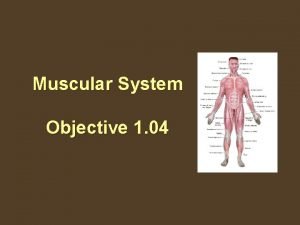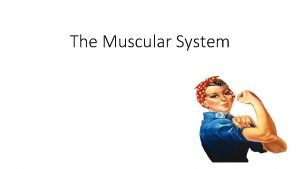MUSCULAR SYSTEM Reading Chapter 8 1 MUSCULAR SYSTEM





































- Slides: 37

MUSCULAR SYSTEM Reading: Chapter 8 1

MUSCULAR SYSTEM A. INTRODUCTION Muscle tissue is: 1) Contractile - unlike other tissue 2) Irritable - responds to stimuli 3) Extensible - can be stretched 4) Elastic - returns to original shape 2

B. FUNCTION 1) Movement a) movement & locomotion b) propulsion c) peristalsis 2) Temperature regulation a. the more activity, the greater the amount of heat produced b. as glucose is burned muscles contract (ATP) 3) Maintenance of posture a. Muscles are slightly contracted b. Fingers are slightly curled 3

C. TYPES OF MUSCLE TISSUE 1) Skeletal - striated a) multinucleated b) nuclei = peripheral c) voluntary 4

C. TYPES OF MUSCLE TISSUE 2) Smooth a) non-striated b) spindle shaped cells c) central nuclei d) involuntary 5

C. TYPES OF MUSCLE TISSUE 3) Cardiac a) striated b) single nuclei that are centrally located c) intercalated disks 6

D. NAMING MUSCLES There are over 800 muscles in the body…some of the ways they are named include: 1) Direction of fibers a) rectus - straight b) transverse - across c) oblique - at an angle 7

D. NAMING MUSCLES (con’t) 2) Location - Anterior or Posterior surface of a bone 3) Size: a) b) c) d) maximus or major = minimus or minor = longus = brevis = 4) Number of origins a) biceps: “bi” = 2 b) triceps: “tri” = 3 8

D. NAMING MUSCLES (con’t) 5) Origin and insertion - sternocleidomastoid 6) Action - flexors and extensors 7) Shape - rhomboideus major & minor 8) Other methods with no rhyme or reason (sorry) 9

E. MUSCLE ATTACHMENTS 1) Origin – point of muscle attachment that doesn’t move during contraction 2) Insertion - muscle attachment that moves the most Action – at contraction, the insertion moves toward the origin 10

F. MUSCLE GROUPS -Muscles can only contract actively -So, most muscles work in pairs 1) Prime mover - causes the action you want 2) Antagonist - opposes this action 3) Synergists - helps the prime mover by “fixing” the joint 11

G. TYPES OF CONTRACTIONS (2 TYPES) 1) Isotonic - iso = “equal”; tonic = “pressure” - muscle shortens, pressure stays the same 2) Isometric - iso = “equal”; metric = “length” - length stays constant, pressure varies 12

MUSCULAR SYSTEM Part 2 of 2 Reading: Chapter 8 13

H. STRUCTURE OF SKELETAL MUSCLE 1) Connective Tissue Layers All muscles = covered by white fibrous CT in various layers (Fig 8. 1) a) FASCIA = “saran wrap” Fascia 14

b) Epimysium: - surrounds each individual muscle c) Perimysium: -surrounds each fascicle (bundle of muscle cells) (Fig 8. 1) d) Endomysium -surrounds individual muscle cells/fibers 15

16

2) Muscle Cell (= muscle fiber) Structure a) sarcolemma - muscle cell membrane (remember plasmalemma? ) b) sarcoplasm - cytoplasm of muscle cells c) sarcoplasmic reticulum - modified S. E. R. - inside sarcoplasm - store Ca++ d) transverse tubules – continuous with cell membrane e) mitochondria – what do they do? Fig 8. 4 (muscle fiber = 1 cell) 17

f) MYOFIBRILS -each cell (fiber) has many myofibrils -myofibrils shorten during contraction -allows the insertion to move toward the origin g) MYOFILAMENTS-smaller units within myofibrils -Two Types: 1) Thick filaments (myosin) 2) Thin filaments (actin) 18

3) Nerve Supply Every muscle cell is connected to a neuron (nerve cell) a) synaptic knob = the end of the neuron b) motor end plate = modified area on sarcolemma where muscle cell meets nerve ending c) synaptic cleft = space b/w motor end plate & synaptic knob Electrical Impulses– travel down neuron Neurotransmitters– released to synaptic cleft - Ex: acetylcholine 19

4) Motor Unit = 1 neuron + all the muscle cells it controls -A motor unit may be 1 neuron + a few muscle cells -A motor unit may be 1 neuron + up to 400 muscle cells 20

I. Skeletal Muscle Contraction In order to understand how muscle contracts, we need to know exactly how it is built. Fascicle/ 21

2) Muscle Cell (= muscle fiber) Structure 22

Myofibril = -the part that contracts -repeating pattern of light & dark bands -the functional unit in a myofibril = sarcomere -filled with smaller myofilaments -2 types of myofilaments = actin & myosin 23

(o 1) Sarcomere (Fig 8. 3) -M line = middle of sarcomere -Z lines = outer borders (lined up w/ adjacent sarcomeres) -Thin filaments (actin) attach at Z lines -Thick filaments (myosin) line up at M line -At rest, the thin and thick filaments do NOT overlap -Pale areas = actin only = I bands -A bands = area encompassing whole myosin band (looks dark) -H zone = pale area at the middle of A band (myosin only) 24

(o 1) Sliding Filament Theory (Fig 8. 9) • • Imagine an isotonic contraction Individual muscle fibers are getting shorter The sarcomeres are getting shorter The actin & myosin fibers stay the same length! The actin & myosin fibers slide past each other A bands = stay the same (but get closer together) I bands = get smaller H band = gets smaller and disappears 25

(o 3) Filaments slide due to cross-bridge formation (Fig 8. 7) • Myosin = many tails stick together (thick) round heads stick up heads have actin binding site • Actin = thin chains have myosin binding sites 26

(o 4) CONTROLLING MUSCLE CONTRACTION Regulatory proteins on actin: troponin & tropomyosin Interaction between Myosin and Actin during muscle contraction: 27

(o 3) Filaments slide due to cross-bridge formation (Fig 8. 7) Where are these “cross-bridges” formed? 28

SLIDING FILAMENT THEORY 1) Contraction a) Nerve impulse ACH released into synaptic cleft b) ACH stimulates motor end plate c) Electrical impulse = on sarcolemma d) Electrical impulse travels into T tubules e) Ca++ released from SR into sarcoplasm 29

f) Ca++ binds with troponin g) Tropomyosin moves to expose myosin binding site h) Myosin cross-bridges may now bind with actin 30

i) Initially, the myosin head is in a low energy state. When the ATP molecule splits, the myosin head enters a high energy state that can bind to actin. 31

j) When the ADP molecule is released, the myosin head rotates towards the H band -“Power Stroke” occurs k) A new ATP binds w/ myosin x-bridge separation l) The x-bridge cocks back & grabs actin again m) The process continues as long as Ca++ & ATP are present 32

Relaxation a) b) c) d) nerve impulse is turned off ACH removed Ca++ pumped back into SR troponin-tropomyosin complex blocks cross-bridges NOTE: -The return of Ca++ back to SR requires ATP -ATP is needed for both contraction & relaxation! -Ca ++ is also needed for contraction (not just ATP) 33

Medical Note: Rigor Mortis • • ATP must bind to myosin for cross-bridges to detach Do you think dead muscle makes ATP? Once ATP runs out…cross-bridges are bound These “rigor-complexes” b/w actin & myosin cannot be broken • After ~ 72 hours proteins movement is restored…why? 34

J. HOW DOES A MUSCLE CHANGE IN SIZE? 1) Hypertrophy -muscle gets bigger -adding more myofibrils -no new cells are formed Stimulated by: a) resistance training b) testosterone c) anabolic steroids 35

MUSCLE SIZE CHANGES (con’t) 2) Atrophy - decrease in muscle size -due to loss of myofibrils or muscle cells. Caused by: a) lack of use b) lack of nervous stimulation c) age 3) Misconceptions 36

K. MUSCLE ABNORMALITIES 1. Muscular Dystrophy: Autosomal dominant_____ 2. Myasthenia gravis: the body’s immune system___ 3. Fibromyalgia: Chronic _______ END 37
 Pre reading while reading and post reading activities
Pre reading while reading and post reading activities Difference between strength and endurance
Difference between strength and endurance Dorsiflexion word parts
Dorsiflexion word parts Chapter 6 the muscular system figure 6-9
Chapter 6 the muscular system figure 6-9 The muscular system chapter 6
The muscular system chapter 6 Chapter 6 the muscular system figure 6-9
Chapter 6 the muscular system figure 6-9 Chapter 7:5 muscular system
Chapter 7:5 muscular system Chapter 9 muscular system
Chapter 9 muscular system Chapter 32 section 3 the muscular system
Chapter 32 section 3 the muscular system Dorsifelxion
Dorsifelxion Chapter 7:5 muscular system
Chapter 7:5 muscular system Chapter 6 the muscular system
Chapter 6 the muscular system Cengage chapter 4 answers
Cengage chapter 4 answers Chapter 6 the muscular system
Chapter 6 the muscular system Chapter 6 the muscular system
Chapter 6 the muscular system Muscles that have their fasciculi arranged like barbs
Muscles that have their fasciculi arranged like barbs Chapter 8 the muscular system
Chapter 8 the muscular system The muscular system chapter 4
The muscular system chapter 4 Sarcromeres
Sarcromeres Myalgia is abnormal softening of muscle tissue
Myalgia is abnormal softening of muscle tissue Round robin reading vs popcorn reading
Round robin reading vs popcorn reading Aims of teaching reading
Aims of teaching reading Types of reading skill
Types of reading skill Guided reading vs shared reading
Guided reading vs shared reading Critical reading active
Critical reading active Intensive reading and extensive reading
Intensive reading and extensive reading Intensive and extensive reading
Intensive and extensive reading What is reading
What is reading Chapter 36 skeletal muscular and integumentary systems
Chapter 36 skeletal muscular and integumentary systems Chapter 14 lesson 3 the nervous system
Chapter 14 lesson 3 the nervous system Three functions of the muscular system
Three functions of the muscular system Primary function of muscular system
Primary function of muscular system Function of muscle
Function of muscle Amazing facts about the muscular system
Amazing facts about the muscular system Perimysium
Perimysium Muscular system label
Muscular system label Muscular system head and neck
Muscular system head and neck Brachiocephalicus
Brachiocephalicus


